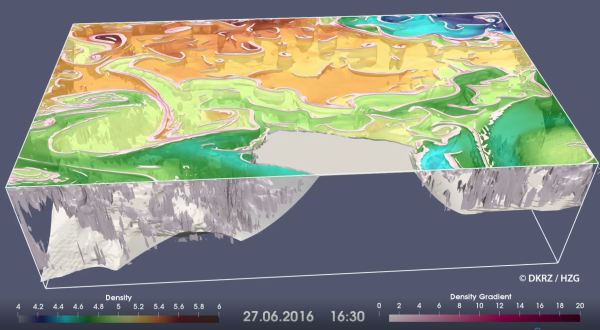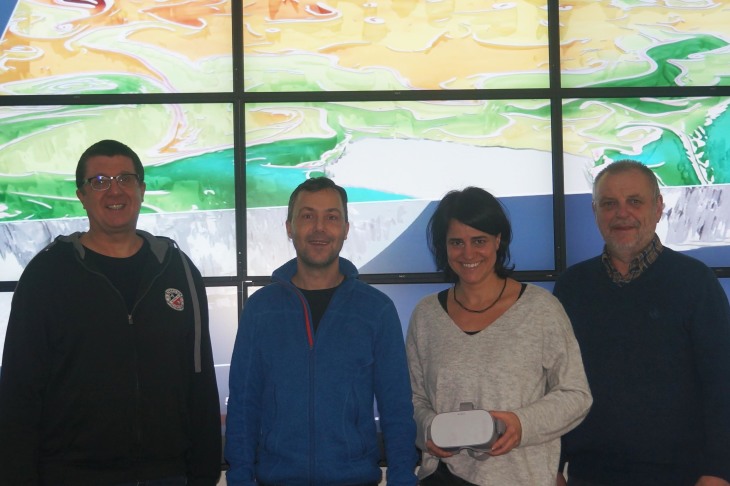Access the Ocean of Knowledge: Experience Science Spatially Through New Software
28.02.2019
On behalf of the German Climate Computing Center (DKRZ) and the Helmholtz-Zentrum Geesthacht (HZG), the KitWare software firm has developed an extension (plugin) for 360-degree projection of ParaView. ParaView is 3D visualization and data analysis software that is widely utilised in science. The plugin was created according to specifications from both establishments. The extension is available immediately to all ParaView users and is free of charge, enabling interactive visualization of 3D data in a virtual 360-degree space using VR goggles and smartphones as well as in domed cinemas.

From climate research to medicine: scientists collect measurement data and create models; they develop computer models and simulate events that cannot be captured using measurements alone. In doing so, they produce huge quantities of data, which result in knowledge and ultimately in progress. This research data is visualized for better interpretation in order to make visible the hidden processes amongst the sea of numbers. The climate and coastal researchers at the DKRZ and the HZG also use ParaView for 3D visualization and studying phenomena such as storms or ocean eddies.
Due to the recently developed software extension, they are taking a great leap forward, diving into their complex data using VR goggles. Through these completely new perspectives, they find further connections and acquire different insights than by viewing the data using a standard approach.
Diving into the Sea of Data – for Science and the Public

Michael Böttinger, visualization expert and employee at the DKRZ, says, “Virtual reality or VR is becoming increasingly important in science. If I myself stand inside an ocean eddy and can see the various temperature nuances from all sides and am completely surrounded by them, I get direct access to information and spatial connections which otherwise would possibly stay buried inside the data.” In addition to visualization in VR goggles, the new plugin enables viewing of 360-degree models even in the planetarium format for fulldome cinemas. As a result, viewers can now be taken on a journey through the world of data. This offers a fascinating experience, enabling viewers to stand right at the centre of climate research.
A first flight through the data was produced using the “Clockwork Ocean” project as an example, generated with the help of the plugin. The viewer can experience ocean eddy modelling data in the Baltic Sea via a link in VR goggles or on a smartphone, using the HZG’s “Discover Science 360” app. Tanja Baschek, employee at the HZG and Clockwork Ocean media coordinator, explains: “I am happy that we are now able to visualize ocean eddies in 360 degrees in order to make invisible processes visible.”
More on the Clockwork Ocean: The Clockwork Ocean expedition took place in the Baltic Sea during the summer of 2016. Small ocean eddies, which are of great significance, were measured from the air and in the water for the first time. A research zeppelin made its world premiere, the first time a zeppelin had ever been utilised for coastal research. The expedition was accompanied by multimedia. In the context of the media project, the science communication for “Clockwork Ocean” won the Best of Science Visualization Award in 2016 in Jena as well as the German Prize for Online Communication in 2018. In conjunction with Clockwork Ocean, two planetarium productions arose, including the “The Eddy Hunt”. Both films were made possible within the framework of the Science Year – Seas and Oceans.
In short 360-degree clips, the Clockwork Ocean expedition can be experienced in virtual reality. Come along on a research expedition and jump aboard a research ship and zeppelin.
Further Information
Download the app
Science 360°
Contact
Tanja Baschek
Public Relations
Helmholtz-Zentrum Geesthacht
Phone: +49 (0) 4152 87-1785
Fax: +49 (0) 4152 87-1640